Coronavirus (COVID-19): modelling the epidemic (issue no.85)
Latest findings in modelling the COVID-19 epidemic in Scotland, both in terms of the spread of the disease through the population (epidemiological modelling) and of the demands it will place on the system, for example in terms of health care requirement.
Coronavirus (COVID-19): modelling the epidemic in Scotland (Issue No. 85)
Background
This is a report on the Scottish Government modelling of the spread and level of Covid-19 in Scotland. This updates the previous publication on modelling of Covid-19 in Scotland published on 7th January 2022. The estimates in this document help the Scottish Government, the health service and the wider public sector plan and put into place what is needed to keep us safe and treat people who have the virus.
This edition of the research findings focuses on the epidemic as a whole, looking at estimates of R, growth rate and incidence as well as local measures of change in the epidemic. It looks at both the impact of the Delta and Omicron variants.
Key Points
- The reproduction rate R in Scotland is currently estimated as being between 1.2 and 1.5, as of 28th December 2021. There has been no change since last week.
- The number of new daily infections for Scotland is estimated as being between 446 and 674 as at 28th December, per 100,000 people.
- The daily growth rate for Scotland is currently estimated as between 4% and 8% as at 28th December. The upper limit has decreased since last week.
- Average contacts from the most recent Panel B cohort of the Scottish Contact Survey (week ending 5th January) indicate an average of 3.7 contacts.
- Mean contacts have decreased within the work and other setting (contacts outside home, school and work) reducing by 32% and 18% respectively. Contacts within the home have increased by 9% over the same period.
- All age groups, with the exception of those aged 18-29, have decreased their contacts. This is largely driven by a reduction in contacts within the work and other setting. The 18-29 age group have reported a similar level of contacts in the last two weeks.
- The biggest increase in interactions are reported between those aged 18-29 with each other in the last two weeks.
- The biggest changes in the proportion of participants visiting different locations are seen in those visiting a pub/restaurant and those visiting another's home. Visits to a pub/restaurant decreased from approximately 39% to 25% while visits to another's home have reported the biggest increase, rising from 47% to 60% in the last two weeks.
- Approximately 63% of individuals had taken at least one lateral flow test within the last 7 days for the survey pertaining to the 2nd – 8th December. This rose to 86% for the survey pertaining to the 30th December 2021 – 5th January 2022.
- The future trajectory of infections is highly uncertain. Hospitalisations, hospital occupancy and deaths are rising and are expected to continue to rise; some Delta infections may also continue. We estimate that daily infections may be between 20,000 and 80,000 by mid-January. This includes the impact of the interventions announced on 14th and 21st December and those announced as being lifted from 17th January, and booster take up.
- Modelled rates of positive tests per 100K using data to 10th January indicate that, for the week commencing 23rd January 2022, 29 of the 32 local authorities are expected to exceed 50 cases per 100K with at least 75% probability. The exceptions are Na h-Eileanan Siar, Orkney Islands and Shetland Islands. The same 29 local authorities also have at least a 75% probability of exceeding 100 cases per 100K.
- 23 local authorities are expected to exceed 300 cases per 100K with at least 75% probability. These are: Aberdeen City, Aberdeenshire, Angus, Argyll & Bute, Clackmannanshire, Dumfries & Galloway, Dundee City, East Ayrshire, East Lothian, East Renfrewshire, Falkirk, Fife, Glasgow City, Inverclyde, Midlothian, Moray, North Ayrshire, Perth & Kinross, Renfrewshire, South Ayrshire, South Lanarkshire, Stirling and West Dunbartonshire.
- 6 local authorities are expected to exceed 500 cases per 100K with at least 75% probability. These are: Angus, Clackmannanshire, Fife, North Ayrshire, Perth & Kinross, and West Dunbartonshire.
- We are not including our usual update on Covid-19 levels in wastewater this week but hope to provide this again in future reports.
- Modelling of long Covid estimates that on 30th January 2022 between 1.2% and 2.9% of the population are projected to self-classify with long Covid for 12 weeks or more after their first confirmed (or suspected) Covid infection in Scotland. The upper and lower limits of the projection of the proportion of the population with long Covid are lower than last week.
- As reported on 5th January 2022, 91.1% of all PCR tests from Pillar 2 Lighthouse Labs had the S-gene target failure, used as a proxy for Omicron cases. Therefore we are no longer producing our estimate of doubling times of the Omicron variant.
Recent cases
Figure 1 shows the number of Covid-19 cases reported in Scotland between December 2021 and January 2022. The vertical dashed lines indicate the cut off points for each of the modelling inputs; after these dates, the number of cases is not incorporated into the outputs.
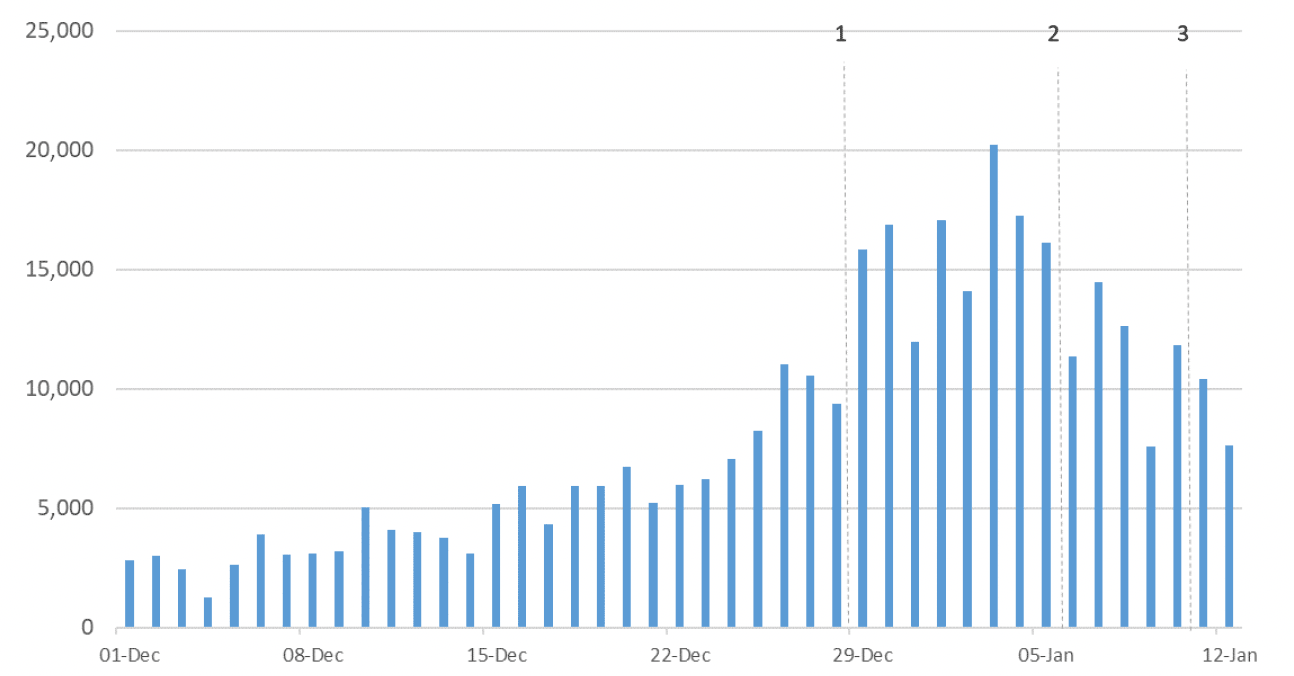
R, growth rate and incidence are as of 28th December 2021 (dashed line 1). The Scottish Contact Survey, the Scottish Government modelling of infections and the long Covid analysis use data to 5th January 2022 (dashed line 2). The modelled rates of positive tests per 100K use data to 10th January (dashed line 3).
On 6th January 2022, given prevalence levels, people are advised that they no longer need to seek a confirmatory PCR test following a positive lateral flow test. This will impact the number of cases reported after 5th January 2022 (dashed line 2). In future weeks we will show the number of cases from either a PCR or lateral flow test[1].
Overview of Scottish Government Modelling
Modelling outputs are provided here on the current epidemic in Scotland as a whole, based on a range of methods. Because it takes a little over three weeks on average for a person who catches Covid-19 to show symptoms, become sick, and either die or recover, there is a time lag in what our model can tell us about any change in the epidemic.
The R value and growth rates are estimated by several independent modelling groups based in universities and the UKHSA. Estimates are considered, discussed and combined at the Epidemiology Modelling Review Group (EMRG), which sits within the UKHSA. These are based on data to 10th January.
UKHSA's consensus view across these methods, was that the value of R as at 28th December[2] in Scotland was between 1.2 and 1.5 (see Figure 2)[3]. This is unchanged since last week.
R is an indicator that lags by two to three weeks and therefore should not be expected to fully reflect the increased prevalence of Omicron in recent weeks.
This week the Scottish Government presented two outputs to EMRG. The first uses confirmed cases, as published by Public Health Scotland (PHS), and deaths from National Records Scotland (NRS). The second uses instead wastewater data to estimate the number of cases, and deaths from NRS. Both outputs are shown in Figures 2 and 3.
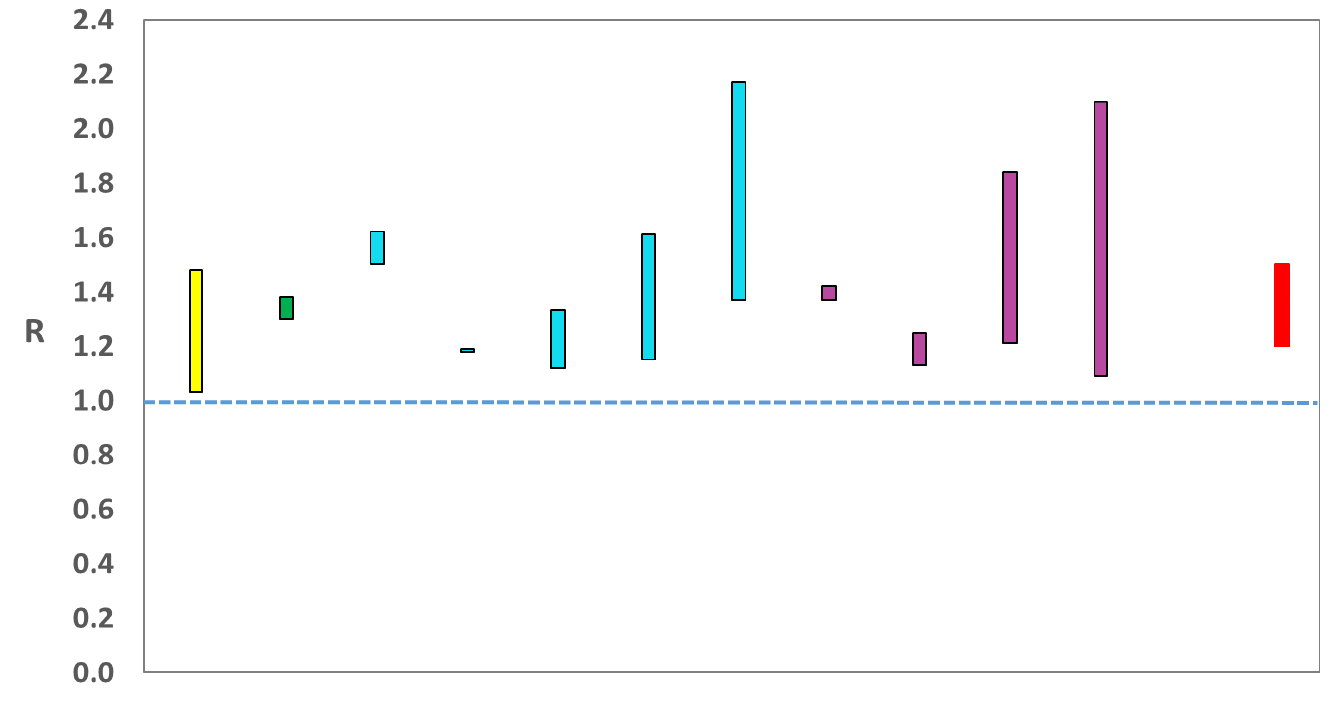
Source: EMRG
The various groups which report to the EMRG use different sources of data in their models to produce estimates of incidence (Figure 3). UKHSA's consensus view across these methods, as at 28th December, was that the incidence of new daily infections in Scotland was between 446 and 674 new infections per 100,000. This equates to between 24,400 and 36,800 people becoming infected each day in Scotland.
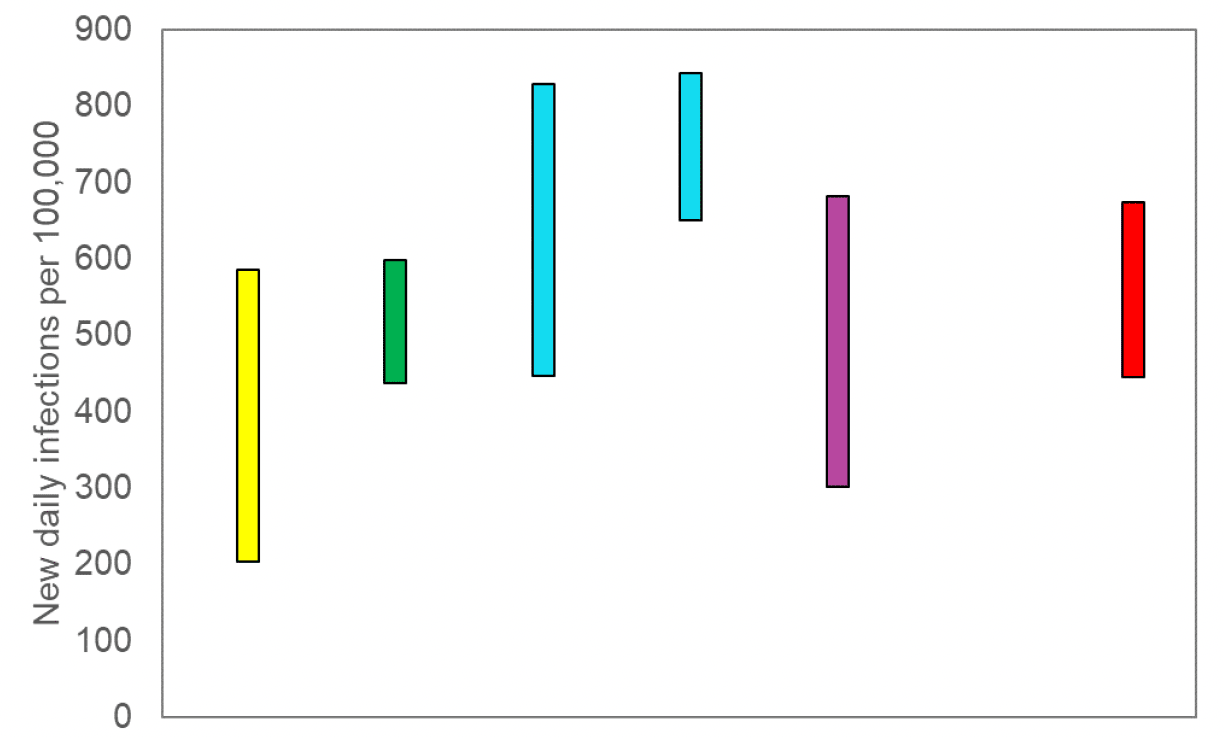
Source: EMRG
The consensus from UKHSA for this week is that the growth rate in Scotland is between 4% and 8% per day as at 28th December. The upper limit has decreased since last publication.
What we know about how people's contact patterns have changed
Average contacts from the most recent Panel B cohort of the Scottish Contact Survey (week ending 5th January) indicate an average of 3.7 contacts. This has decreased by 16% compared to the previous Panel B of the survey (week ending 22nd December), as seen in Figure 4. Mean contacts have decreased within the work and other setting (contacts outside home, school and work) reducing by 32% and 18% respectively. Contacts within the home have increased by 9% over the same period.
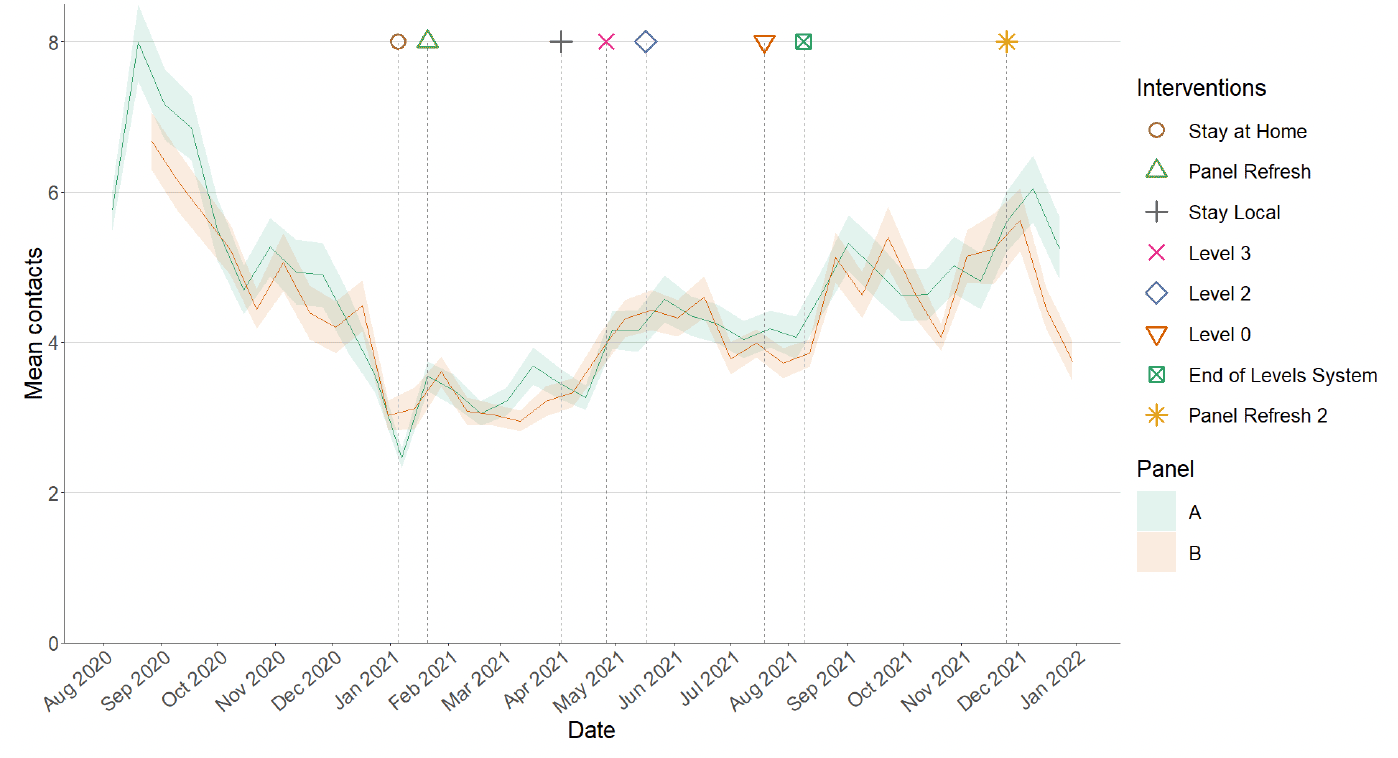
Figure 5 shows how contacts change across age group and setting. All age groups, with the exception of those aged 18-29, have decreased their contacts. This is largely driven by a reduction in contacts within the work and other setting. The 18-29 age group have reported a similar level of contacts in the last two weeks.
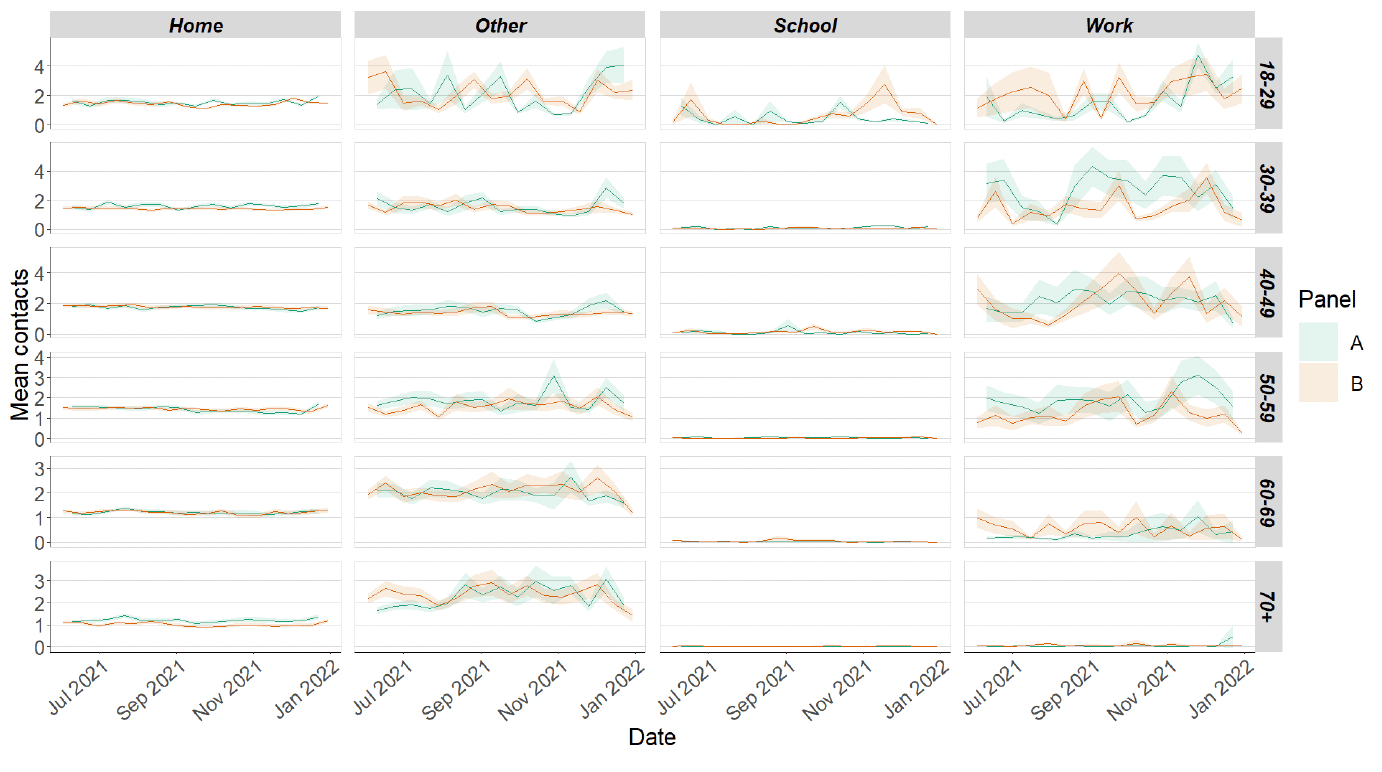
The heatmaps in Figure 6 show the mean overall contacts between age groups for the weeks relating to 16th December - 22nd December and 30th December 2021 - 5th January 2022 and the difference between these periods. The biggest increase in interactions are reported between those aged 18-29 with each other in the last two weeks.
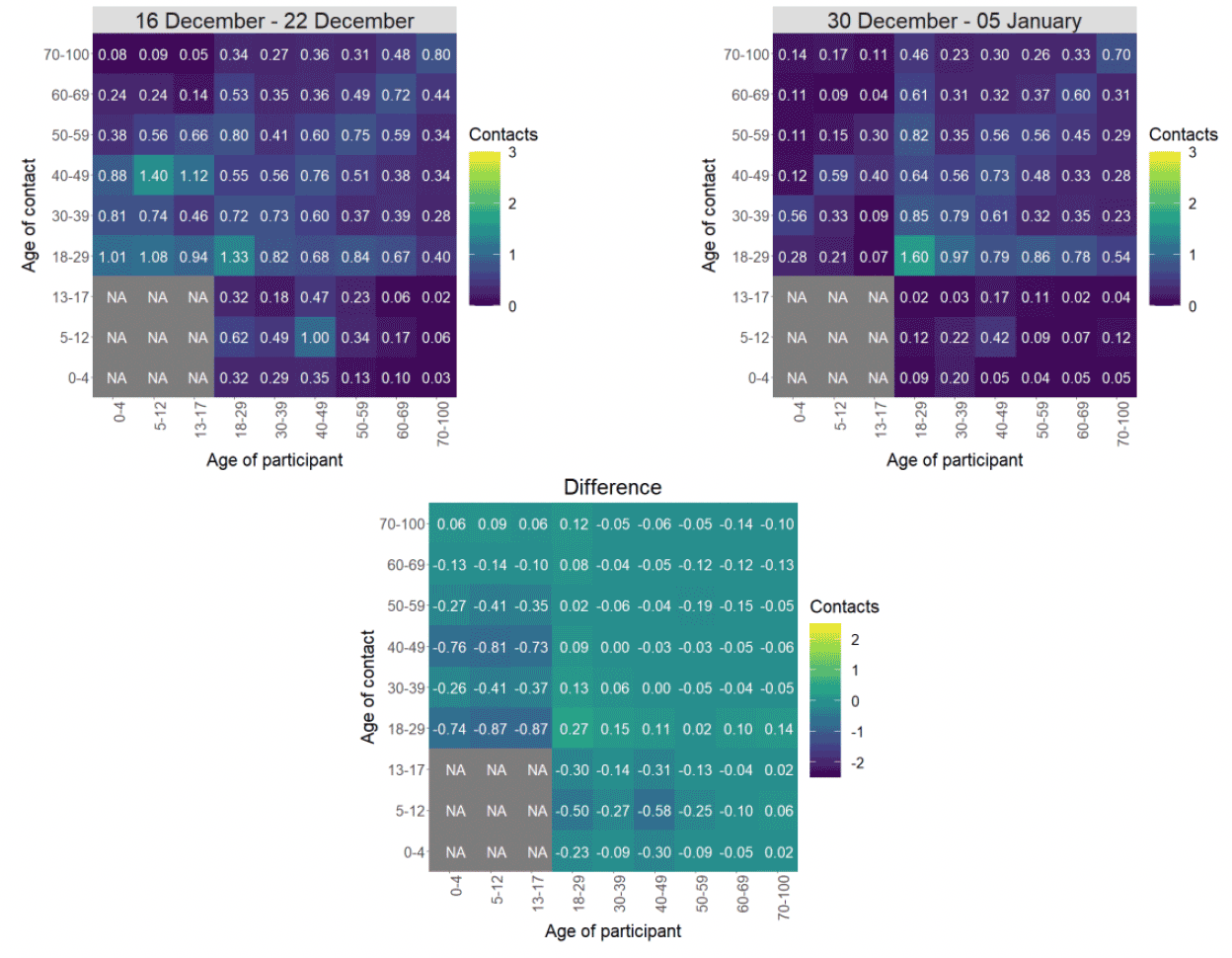
As shown in Figure 7, the biggest changes in the proportion of participants visiting different locations are seen in those visiting a pub/restaurant and those visiting another's home. Visits to a pub/restaurant decreased from approximately 39% to 25% while visits to another's home have reported the biggest increase, rising from 47% to 60% in the last two weeks.
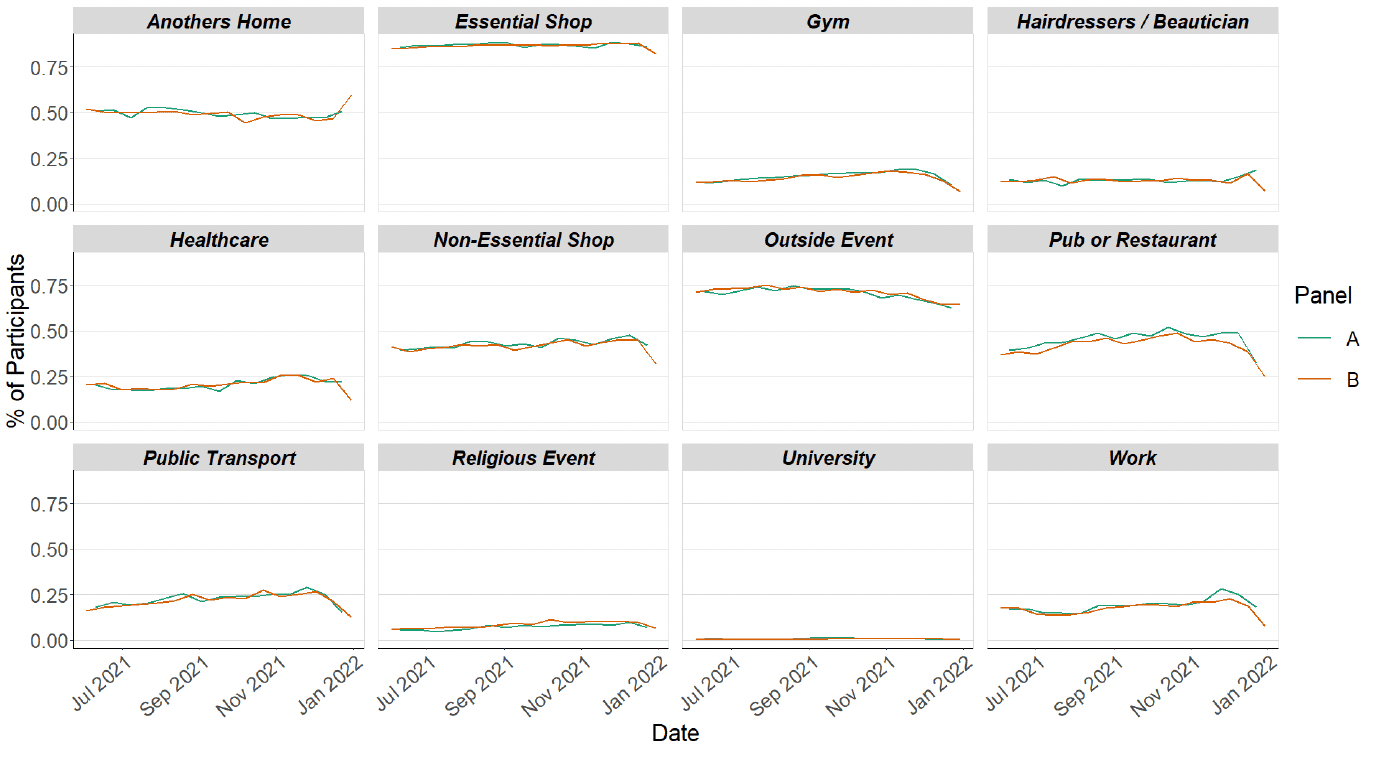
Approximately 63% of individuals had taken at least one lateral flow test within the last 7 days for the survey pertaining to the 2nd – 8th December. This rose to 86% for the survey pertaining to the 30th December – 5th January as shown in Figure 8.
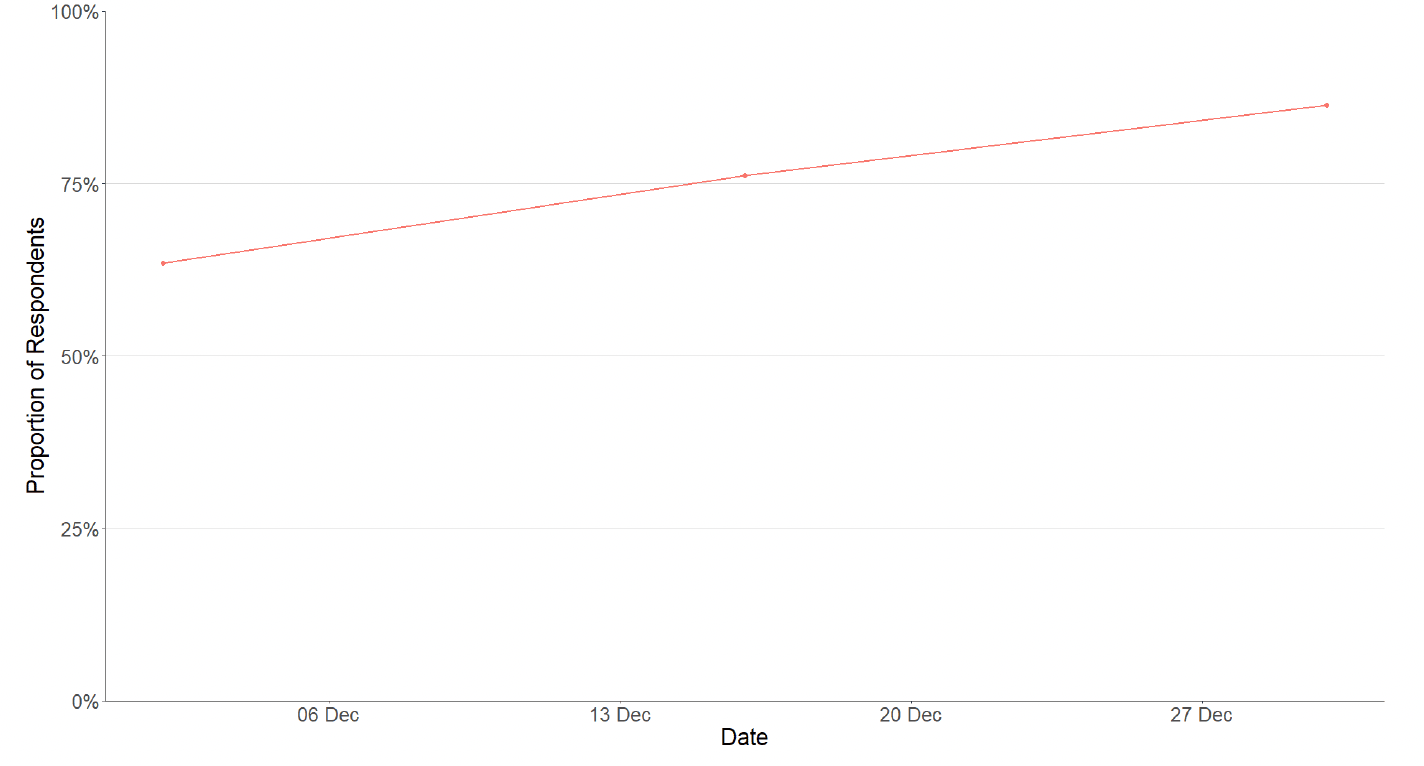
What the modelling tells us about estimated infections
The Scottish Government assesses the impact of Covid-19 on the NHS in the next few weeks, in this research findings we focus on estimating the number of infections. Figure 9 show projections over the four weeks for combined Delta and Omicron infections.
These projections include the effect of the interventions announced on 14th and 21st December 2021, and those being announced as being lifted from 17th January 2022, and booster take up. 'Central' assumes a continuation of the current trend for Delta, and that Omicron is around two times more transmissible. 'Worse' assumes a higher transmissibility for both Delta and Omicron. 'Better' assumes a lower transmissibility for both variants. All projections also assume a lower vaccine effectiveness[5] for Omicron than for Delta[6].
Delta infections are likely to fall over time based on the current level of restrictions, but those still being infected and already infected will still contribute to the numbers of people in hospital and ICU. Meanwhile the future trajectory of infections is highly uncertain.
Due to uncertainty in case data reported following the announcement removing the need for a confirmatory PCR test in some cases we have only used data reported up to 5th January.
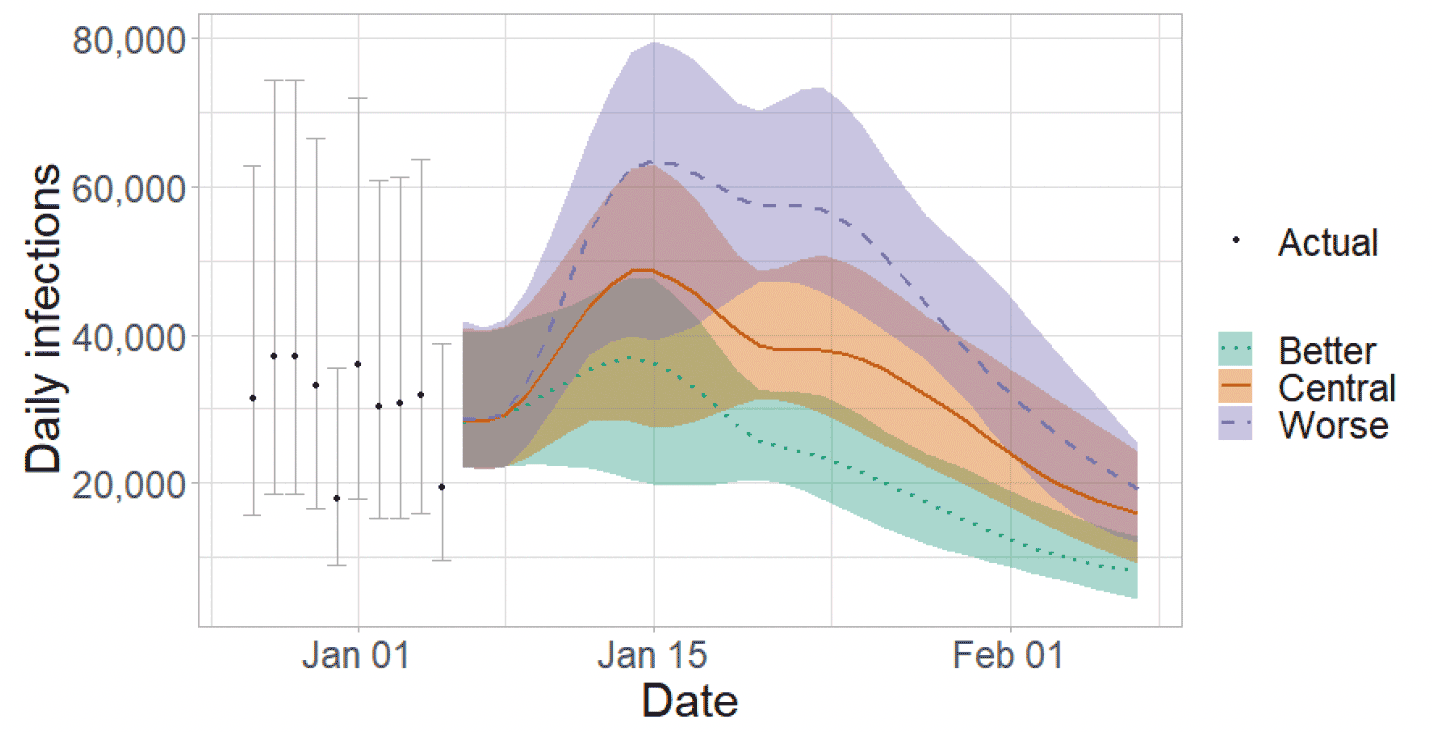
We estimate that daily infections may be between 20,000 and 80,000 by mid-January. By 7th February daily infections are estimated to be between 5,000 and 26,000.
What the modelling tells us about projections of hospitalisations, occupancy and deaths in the medium term
SPI-M-O produces projections of the epidemic (Figures 10 - 12), combining estimates from several independent models. These projections are not forecasts or predictions. They represent a scenario in which the trajectory of the epidemic continues to follow the trends that were seen in the data available to 10th January and do not include the effects of any future policy or behavioural changes.
Disruption to data flows and behaviour changes over the festive period makes it difficult to interpret recent trends in the data.
The delay between infection, developing symptoms, the need for hospital care, and death means they cannot fully reflect the impact of behaviour changes in the two to three weeks prior to 10th January.
The projections include the potential impact of vaccinations over the next few weeks. Modelling groups have used their expert judgement and evidence from UKHSA, Scottish Universities & Public Health Scotland, and other published efficacy studies when making assumptions about vaccine effectiveness.
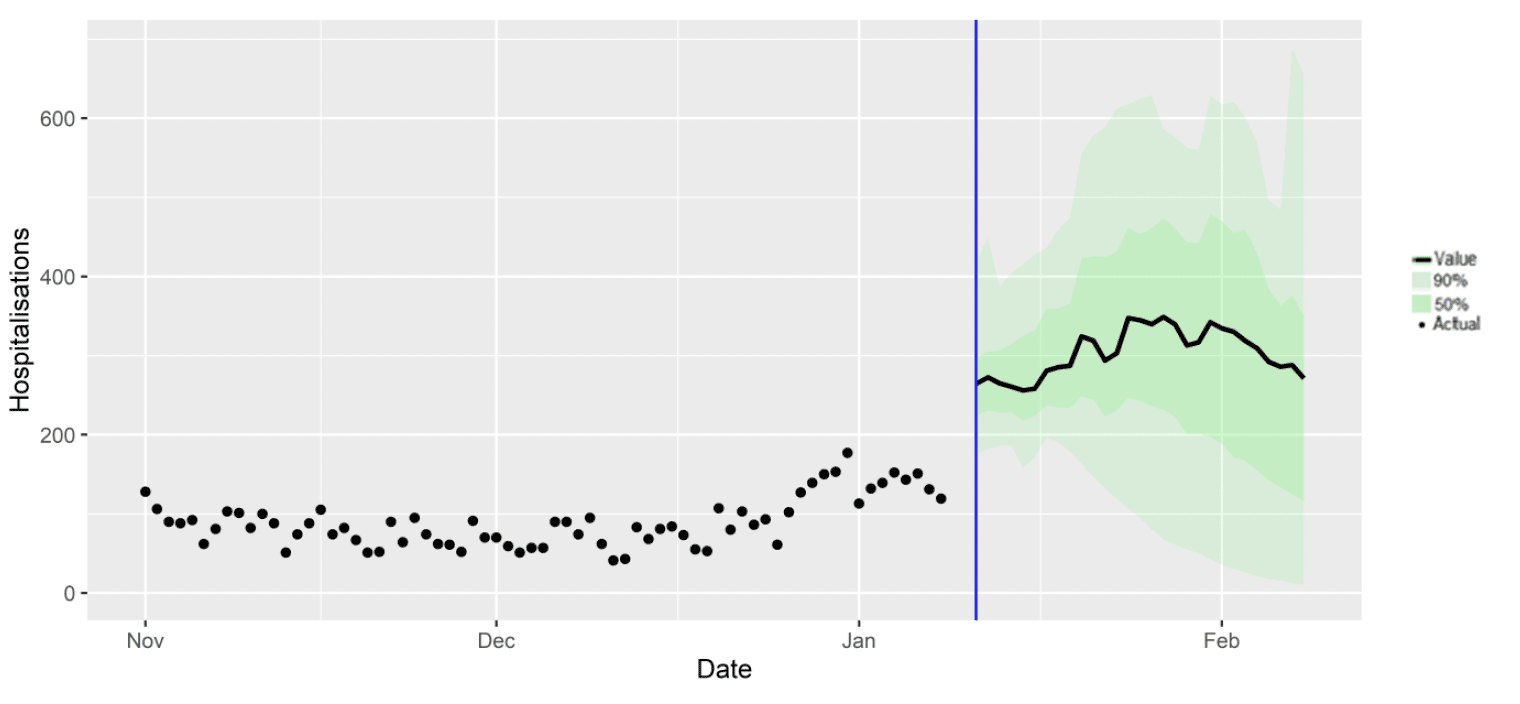
Last week we provided hospital occupancy based on two modelling groups, including the Scottish Government. This week we are able to provide a SPI-M-O consensus on occupancy, see Figure 11.
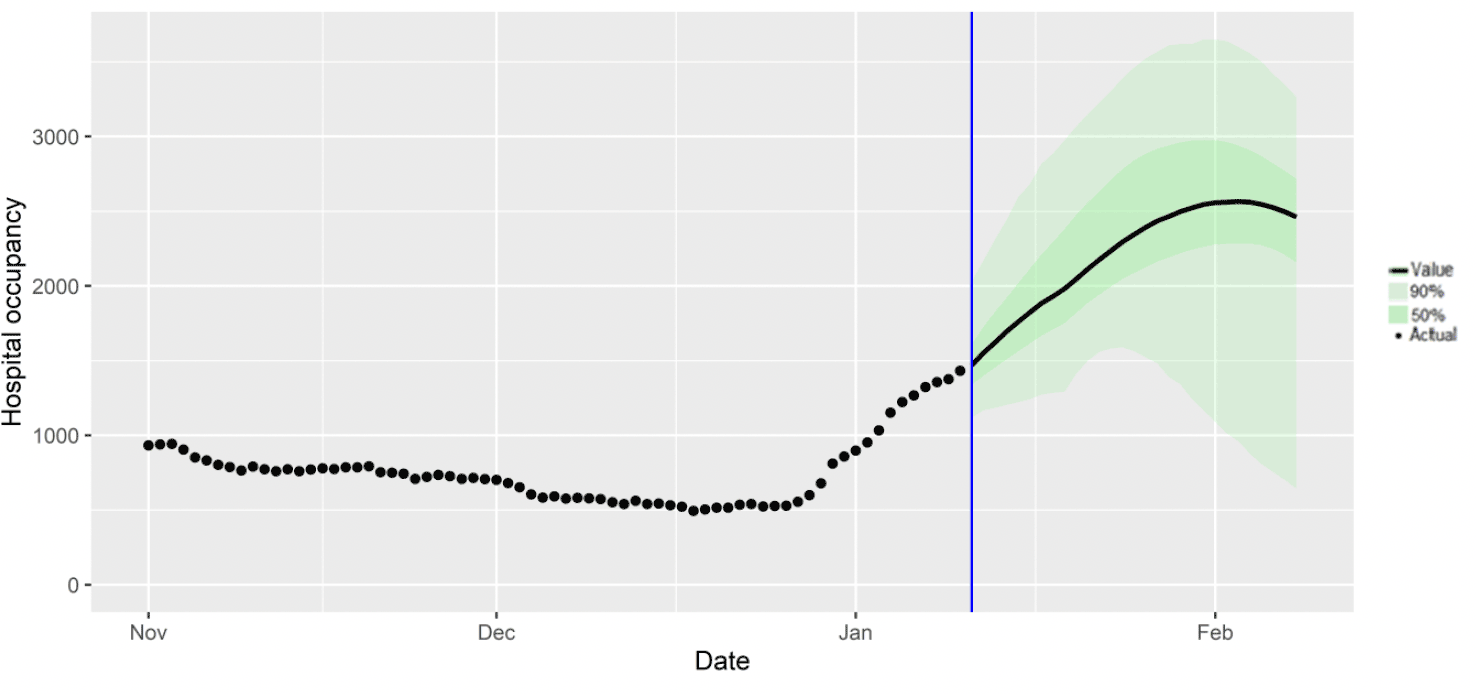
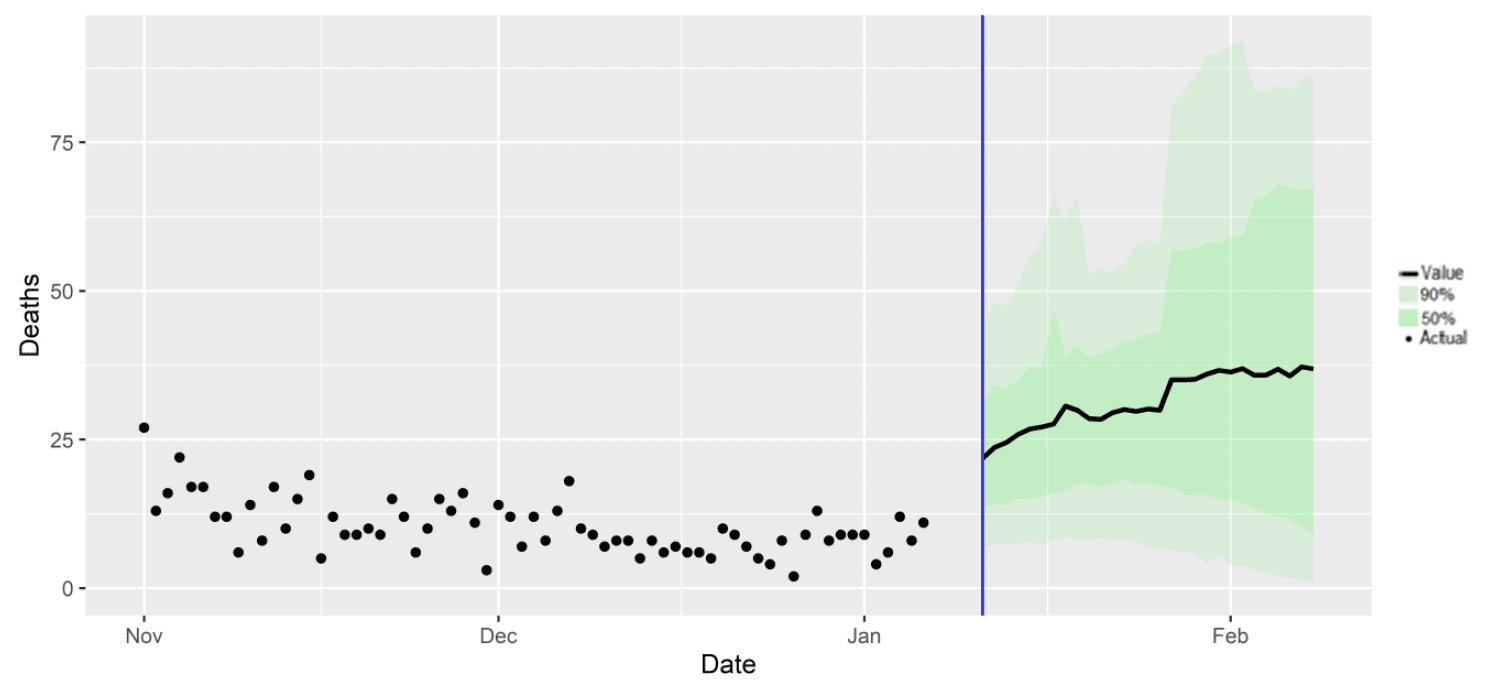
What we know about which local authorities are likely to experience high levels of Covid-19 in two weeks' time
We continue to use modelling based on Covid-19 cases and deaths using data to 10th January from several academic groups to give us an indication of whether a local authority is likely to experience high levels of Covid-19 in the future. This has not been compiled via UKHSA into a consensus this week and is based on one modelling group. The increased uncertainty due to differences in case reporting over Christmas is less influential in the modelled estimates this week. However, many Scottish regions are at what could be a turning point in case data. Turning points are detected to different degrees by the modelling.
In this, an area is defined as a hotspot if the two week prediction of cases (positive tests) per 100K population is predicted to exceed a threshold, e.g. 500 cases.
Modelled rates of positive tests per 100K using data to 10th January indicate that, for the week commencing 23rd January 2022, 29 of the 32 local authorities are expected to exceed 50 cases per 100K with at least 75% probability. The exceptions are Na h-Eileanan Siar, Orkney Islands and Shetland Islands. The same 29 local authorities also have at least a 75% probability of exceeding 100 cases per 100K.
23 local authorities are expected to exceed 300 cases per 100K with at least 75% probability. These are: Aberdeen City, Aberdeenshire, Angus, Argyll and Bute, Clackmannanshire, Dumfries & Galloway, Dundee City, East Ayrshire, East Lothian, East Renfrewshire, Falkirk, Fife, Glasgow City, Inverclyde, Midlothian, Moray, North Ayrshire, Perth & Kinross, Renfrewshire, South Ayrshire, South Lanarkshire, Stirling and West Dunbartonshire.
6 local authorities are expected to exceed 500 cases per 100K with at least 75% probability. These are: Angus, Clackmannanshire, Fife, North Ayrshire, Perth & Kinross and West Dunbartonshire.
What can analysis of wastewater samples tell us about 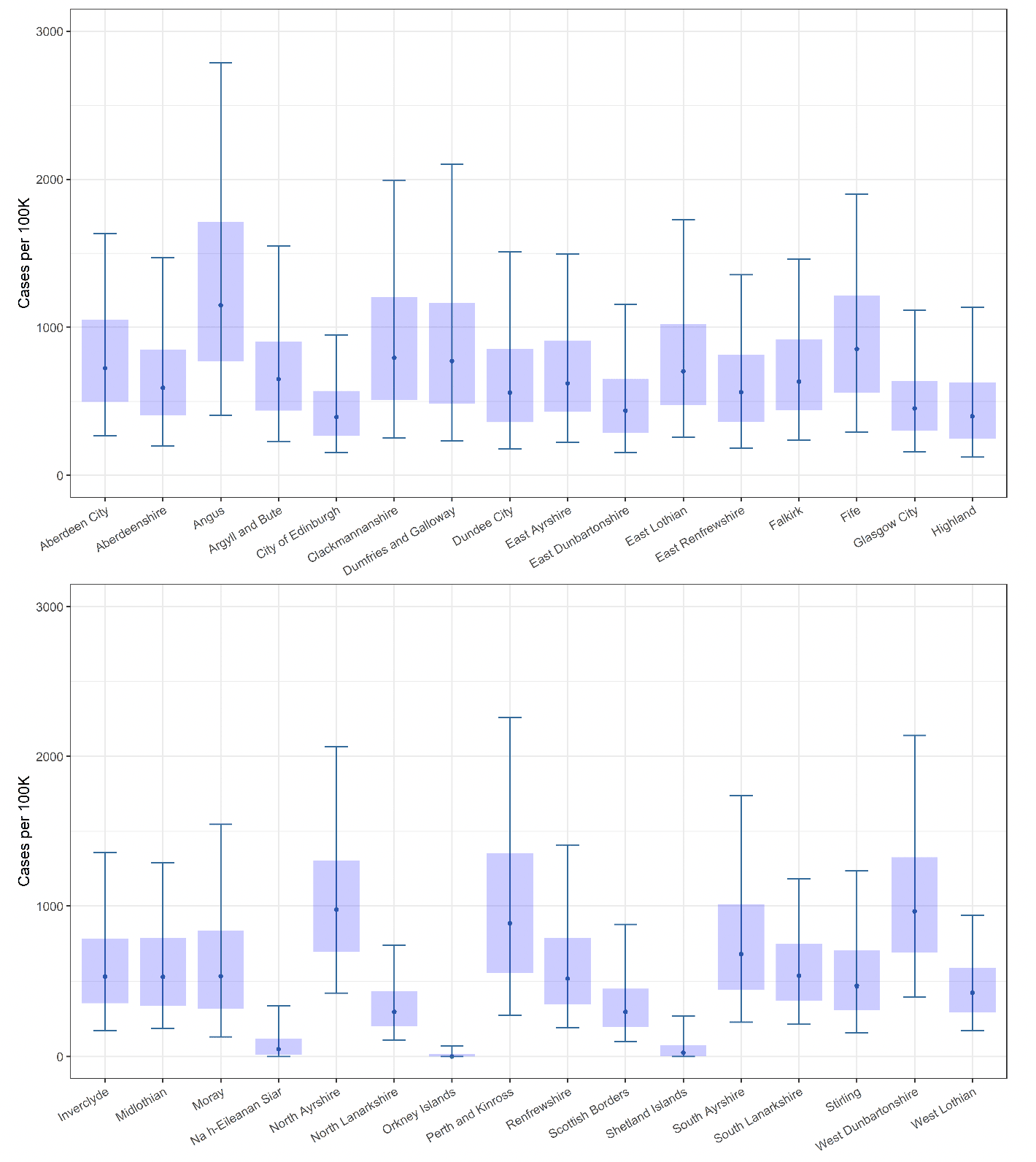 local outbreaks of Covid-19 infection?
local outbreaks of Covid-19 infection?
We are not including our usual update on Covid-19 levels in wastewater this week but hope to provide this again in future reports.
What estimates do we have of the number of people experiencing long Covid symptoms?
The Scottish Government is modelling the number of people likely to experience long Covid symptoms. This gives a projection of estimated self-reported long Covid rates in the future, based on Scottish Government medium term projection modelling, as set out in Figure 14.
This modelling estimates that at 30th January 2022 between 64,000 (1.2% of the population) and 160,000 (2.9%) people are projected to self-classify with long Covid for 12 weeks or more after their first suspected Covid infection in Scotland.
These are preliminary results, further data on rates of long Covid and associated syndromes as research emerges are required.
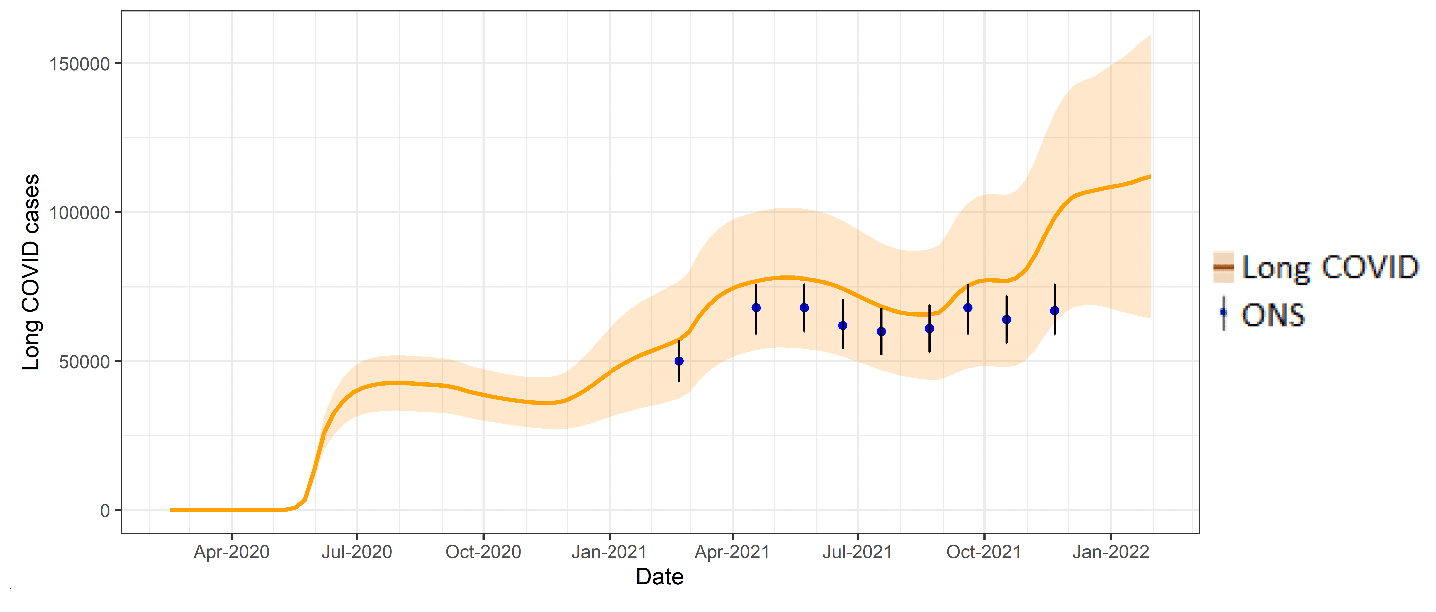
See the Technical Annex in issue 73 for information about the methodology.
What next?
Modelling will be provided for both the Delta and Omicron variants where possible. As more information on Omicron becomes available this will be incorporated in the different models as and when it is appropriate to do so.
Technical Annex
Epidemiology is the study of how diseases spread within populations. One way we do this is using our best understanding of the way the infection is passed on and how it affects people who catch it to create mathematical simulations. Because people who catch Covid-19 have a relatively long period in which they can pass it on to others before they begin to have symptoms, and the majority of people infected with the virus will experience mild symptoms, this "epidemiological modelling" provides insights into the epidemic that cannot easily be measured through testing e.g. of those with symptoms, as it estimates the total number of new daily infections and infectious people, including those who are asymptomatic or have mild symptoms.
Modelling also allows us to make short-term forecasts of what may happen with a degree of uncertainty. These can be used in health care and other planning. The modelling in this research findings is undertaken using different types of data which going forward aims to both model the progress of the epidemic in Scotland and provide early indications of where any changes are taking place.
The delivery of the vaccination programme will offer protection against severe disease and death. The modelling includes assumptions about compliance with restrictions and vaccine take-up. Work is still ongoing to understand how many vaccinated people might still spread the virus if infected. As Covid-19 is a new disease there remain uncertainties associated with vaccine effectiveness. Furthermore, there is a risk that new variants emerge for which immunisation is less effective.
How the modelling compares to the real data as it emerges
The following charts show the history of our modelling projections in comparison to estimates of the actual data. The infections projections were largely accurate from mid-January 2021 until mid-December 2021, from which point the projections have underestimated the number of infections, due to the unforeseen effects of the Omicron variant. The same is true for the hospital beds projections, however the ICU beds projections have overestimated the actual figures since mid-December 2021, due to the lower severity of Omicron.
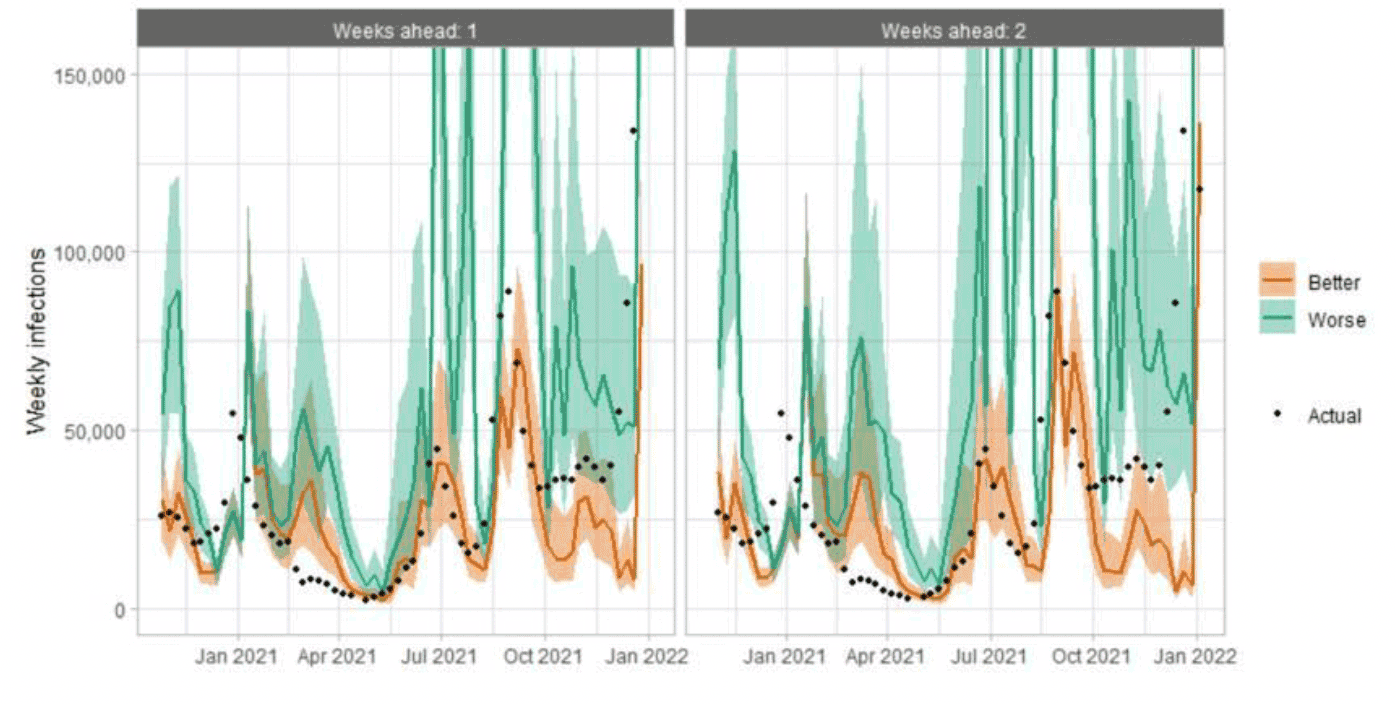
Hospital bed projections have generally been more precise than infections estimates due to being partially based on already known information about numbers of current infections, and number of people already in hospital. The projections are for number of people in hospital due to Covid-19, which is slightly different to the actuals, which are number of people in hospital within 28 days of a positive Covid-19 test.
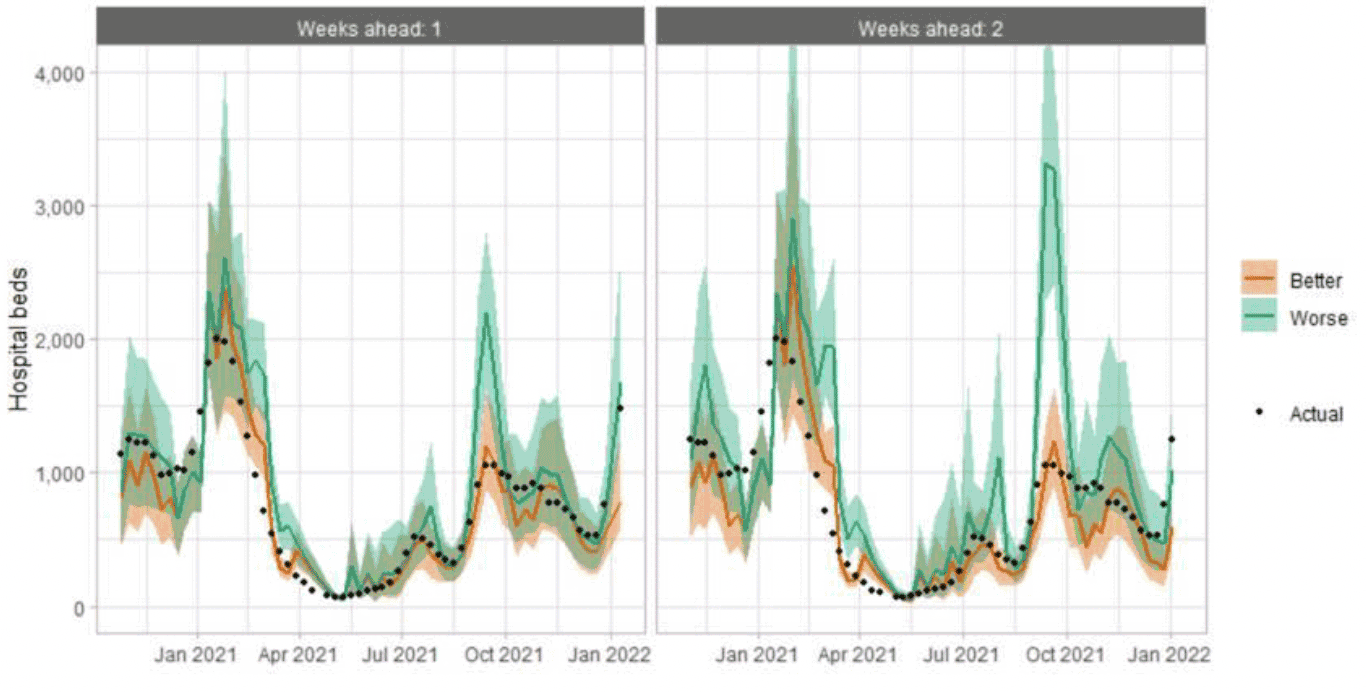
As with hospital beds, ICU bed projections have generally been more precise than infections. The projections are for number of people in ICU due to Covid-19. The actuals are number of people in ICU within 28 days 22 of a positive Covid-19 test up to 20 January 2021, after which they include people in ICU over the 28 day limit.
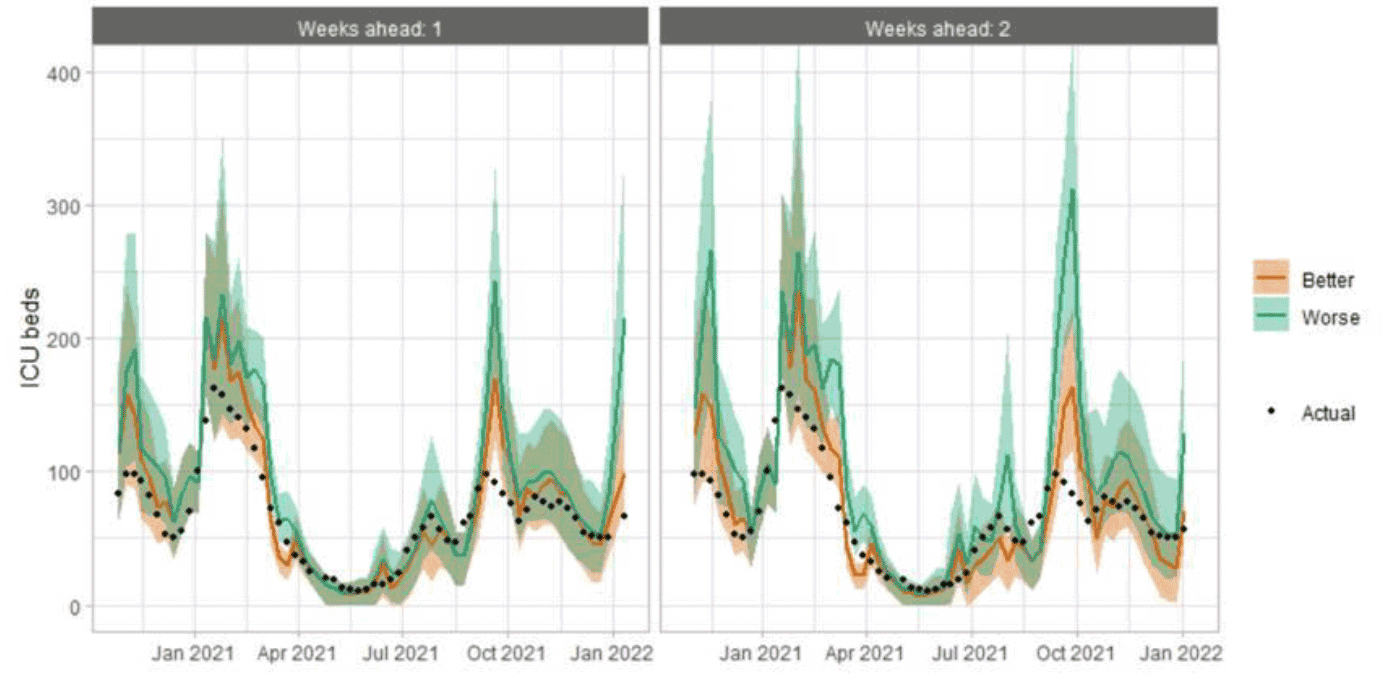
Contact
There is a problem
Thanks for your feedback